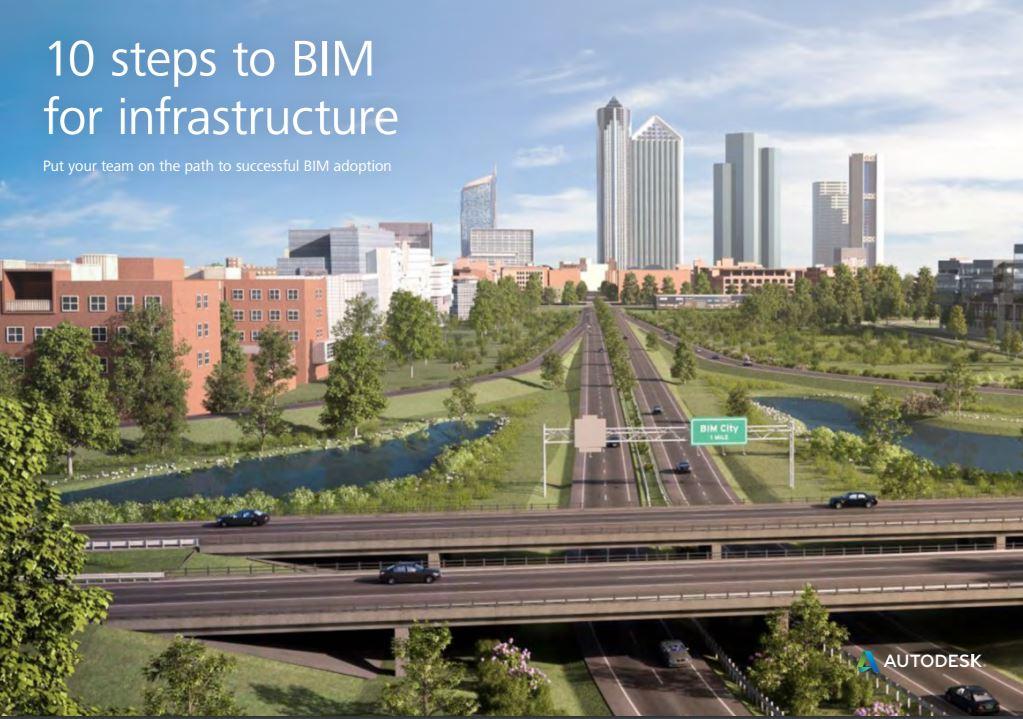
If your agency or organization is thinking of moving to BIM for your infrastructure projects you’re probably wondering where to start. The good news is you are more BIM-ready than you thought. However, that doesn’t mean you can make the move overnight, although it may take less time than you think.
In this handy eBook – 10 Steps to BIM for Infrastructure – from DLT partner, Autodesk, learn how to put your team on the path to a successful BIM adoption. Interested to know more? Here are some snippets of wisdom from the eBook to help chart your adoption of BIM for infrastructure.
1. Get to know BIM
The first step is to designate one or two people at your organization to learn more about BIM and how it will affect the way your team works. This means focusing not just on software and any preconceptions that BIM is just about 3D visualization, but on process. Talk to peers who already use BIM. Ask them how it’s changed their workflows, what surprised them about the process, where are they seeing the most benefits, and what advice they’d give you as you transition to BIM.
2. Communicate the change to your people
Stress that BIM isn’t a choice or something that you’re just trying out. Make it clear, from the top, that your moving to BIM because it’s critical to your mission and your future. Then help your team look beyond the mandate to what’s in it for them. Discuss how BIM can help save time on critical tasks, improve collaboration, facilitate data reuse, and so on.
3. Account for software and hardware needs
To reiterate again, BIM isn’t software – it’s a process. As such, an end-to-end BIM process requires more than just one software. For example, your core BIM application should connect to the application used to rapidly create concepts that capture existing conditions. Your hardware also needs to be powerful enough to run BIM applications quickly.
4. Plan your shift
The steps outlined here can help with change management, but your wider plan needs to address your way of working and typical projects you encounter. How will BIM change your current workflows? Who needs training and when will they get it? How will you support teams who have questions and issues?
It’s useful to designate a BIM champion or two who can undertake in-depth training and become a go-to resource for everyone else.
5. Document standards
Because every object in BIM is intelligent – meaning it contains information about itself and how it should relate to other objects in your design – standards are essential. BIM standards define what objects “know” about themselves and need to be established for everything you do. Don’t be daunted, there are ways to accelerate the process. Pre-existing libraries of BIM standards exist (such as those provided by the National BIM Standard in the U.S and others) – just select the standards closest to what you use today and then have your BIM champions modify and adapt them.
6. Start incorporating BIM on projects
Your colleagues in building design and construction may recommend you start a BIM pilot project. But this approach doesn’t always work in infrastructure and may hamper your move to BIM. That’s because infrastructure projects can last several years – a long time before you see results. Instead, introduce BIM into existing projects. For example, using BIM to design the drainage network on a highway project will expose more people to BIM sooner and help you realize a faster return on investment.
7. Document processes
Now that you have an initial project underway, start to document preferred processes. How are workflows changing? Share these observations with others. Project leaders should also revisit BIM standards to make sure they still support specific projects and preferences.
8. Train and transition the rest of the team
Even with just a few weeks of on-the-job BIM experience your BIM champions might be ready to help the team move to BIM. Familiarize everyone with BIM processes and tools by having your champions walk through their BIM projects step-by-step. Augment with on- or off-site training from experienced BIM trainers.
9. Integrate with other models
The benefits of BIM really come to light when you share models with other organizations, such as contractors (e.g. structural engineers) or peer agencies/departments. Integrating models into a single, shared model accelerates the coordination process and opens the door to a new level of collaboration.
10. Expand and innovate with BIM
As you master BIM processes, add new capabilities. Explore starting projects with existing condition models. You can create models rapidly by using GIS data, aerial surveys, and environmental data. You can even sketch alternatives that include intelligent objects your design tools will later recognize.
Refer to the eBook for more steps and examples of how you can get started with BIM for infrastructure projects. And check out our blogs on the topic of BIM for infrastructure.
Related
• The Importance of BIM Standards
• How to Integrate CAD and BIM Standards for AEC Projects
















































